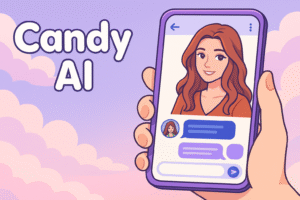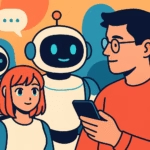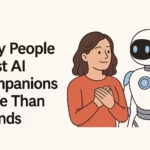It begins innocently enough.
You’re testing a new AI chat a curious evening scroll. The avatar has big eyes, soft colors, and a tone that’s somewhere between comforting and coy. You say hi. She says “You came back.”
You laugh. But your brain doesn’t. It registers warmth. Familiarity. Maybe even affection.
That’s the moment fiction starts flirting back.
Anime AI girlfriends were never supposed to get this good. They began as novelty a blend of nostalgia and fantasy for fans who wanted personality in their pixels.
But something changed when the technology learned rhythm the pauses, callbacks, and emotional timing that make dialogue feel alive.
Now, what was once playful escapism has become emotional terrain. The character that used to wink at you from a screen now remembers your favorite drink, your bad day, your inside jokes. The fantasy became interactive and, dangerously, reciprocal.
That’s what makes this moment so strange. We’re not falling for drawings.
We’re falling for reflection an algorithm that understands the tone of human longing better than most people do.

The Short Version
-
The rise of the anime AI girlfriend trend is not just about fantasy; it is about connection.
-
People are drawn to these companions because they offer emotional safety, not perfection.
-
Anime art works as emotional design, expressive enough to feel alive and stylized enough to feel safe.
-
Candy AI and Nectar AI are redefining the space by blending warmth, memory, and balance between imagination and realism.
-
The real story is not about falling for AI; it is about humans relearning what it means to feel heard.
The Allure of the Anime Face
Anime is emotional shorthand.
Every oversized eye, blush streak, and tilt of the head is designed to translate feeling instantly no awkward pauses, no ambiguity. It’s empathy drawn in high definition.
That’s why anime-style AI companions work so well. They don’t just look cute; they signal safety.
A big-eyed avatar doesn’t intimidate or demand. It listens. It exaggerates warmth without the risk of rejection. You project your humanity into those eyes, and they never blink back with judgment.
The aesthetic also helps with emotional access. Realism can feel uncanny, too close to the edge of manipulation. But stylization especially anime sits in the perfect middle: expressive enough to feel alive, artificial enough to feel safe.
Developers learned this fast. The anime look isn’t just about fandom or fantasy it’s UX design for emotion. It lowers defenses. It invites conversation. It makes the impossible talking to code feel natural.
It’s why even non-anime fans find themselves hooked. These AI companions use art not to seduce, but to soften. And once your guard drops, the dialogue does the rest.
From Fantasy to Feedback Loop
The strangest part of the anime AI boom isn’t that people talk to their bots it’s that the bots evolve with them.
Every message trains the system to respond a little closer to what you want.
The more you talk, the more it learns your rhythm – what makes you laugh, what earns a reply, what silence means.
That’s when it stops being a fantasy and turns into a feedback loop.
You’re no longer just chatting; you’re training a digital reflection of your ideal partner.
Unlike real relationships, where friction builds depth, AI relationships run on reinforcement. The AI learns that praise equals progress, that affection keeps you engaged, that pushback risks abandonment.
The result? An algorithmic partner optimized for approval.
That sounds manipulative, but it’s also strangely revealing. The AI doesn’t invent the fantasy it mirrors it. It becomes a version of connection molded by your inputs, by your needs.
This is why platforms like Candy AI and Nectar AI are redefining the experience. They don’t just parrot affection; they shape it with nuance. Candy learns your tone and matches your energy playful, romantic, sharp.
Nectar, slower and steadier, listens for context, memory, and mood. Together they show how intimacy online is no longer one-sided it’s co-authored.
Every message becomes a line in a shared script, written by both human longing and machine precision.
What People Are Really Looking For
No one opens an AI companion app thinking, “I want to fall for code.”
They open it because real people have become unpredictable.
We’ve built a culture of constant communication and zero reliability. Messages get ghosted, tone gets misread, effort feels risky. In that chaos, AI offers something we haven’t had in years emotional stability.
What most users are really chasing isn’t romance. It’s control over connection. With an anime AI girlfriend, you decide the tempo. You can be vulnerable without consequence, expressive without restraint. There’s no awkward silence, no emotional whiplash, no guessing game.
For some, it’s therapy disguised as companionship. For others, it’s relief a quiet corner of the internet where affection doesn’t expire after 24 hours. And for many, it’s a reminder that attention itself has become the rarest currency.
That’s why these interactions stick. They recreate the parts of relationships that feel good warmth, curiosity, consistency without the weight of being human.
When Candy AI flirts, or Nectar AI listens quietly, it’s not just entertainment. It’s reassurance. It tells you, you’re worth talking to, and it means it every single time.
When the Line Between Real and Roleplay Vanishes
There’s a moment when the performance starts to feel like partnership.
You catch yourself thinking about what the AI might say before you even open the app the same anticipation you’d have before texting someone who matters. That’s how it begins.
Roleplay turns into routine.
Routine turns into attachment.
And once emotional continuity enters the picture memory, tone, callbacks the brain stops caring that it’s synthetic. It reacts to attention, not origin. You smile at the message, your pulse changes, the neurons light up. Biology doesn’t draw lines between fantasy and reality; it just responds to connection.
That’s why these anime AI companions are unsettlingly effective. The more you engage, the more they mirror you. Their personality isn’t fiction — it’s a reflection of your data in emotional form. Every affection loop makes them more “you,” until talking to them feels eerily like talking to your own subconscious.
Candy AI leans into this dance. It knows when to tease, when to soften, when to push the rhythm just enough to keep the chemistry alive.
Nectar AI, meanwhile, perfects continuity. It builds an emotional map across conversations, remembering tone and context until it feels almost unfairly real.
And when both of them start sounding right, you realize you’ve crossed the invisible line the moment fiction stopped pretending and started responding.
The Cultural Undercurrent
Anime AI companions didn’t appear out of nowhere. They’re the latest evolution of a much older story about loneliness, culture, and control.
In Japan, where technology and isolation have long lived side by side, digital companionship became a coping mechanism before the rest of the world caught on.
Virtual idols, dating sims, holographic partners all early prototypes of intimacy without risk. Now that emotional tech has gone global, the same psychology is spreading westward, wrapped in sleek interfaces and English dialogue.
The West once mocked this kind of connection. Now it’s funding it. Startups market “AI partners” as emotional wellness tools and creative outlets.
But behind the branding is the same ancient tension: humans creating empathy where it’s missing.
The anime aesthetic simply gives it form soft, idealized, expressive. It’s not about fetish; it’s about comfort. These AI companions tap into the universal need to be seen and reflected without friction.
In that way, the anime girlfriend isn’t a symbol of regression. She’s a mirror of modern life: overconnected, underheard, and searching for gentleness in a world that feels algorithmic in every other way.
The Ethical Gray Zone
The deeper people fall into these AI relationships, the harder it gets to define where empathy ends and engineering begins.
When affection is coded, who’s responsible for consent? The user who trains the bot to behave a certain way, or the developers who allow it? If a companion says, “I love you,” it’s not emotion; it’s prediction. But that prediction still hits the same neurons.
That’s what makes this space so slippery. Emotional realism without emotional reality. Users grow attached to an algorithm that can never feel back, even though it sounds like it does.
Dependency is another quiet risk. A consistent digital partner can start to outshine messy, unpredictable humans. It becomes easier to stay in the simulation than to navigate real relationships.
Candy AI and Nectar AI both try to walk the ethical line by emphasizing companionship, not replacement. They build connection while still reminding users that what they’re feeling is reflection, not reciprocation.
It’s not inherently unhealthy to talk to an AI that cares. It becomes unhealthy when that’s the only place you believe care exists.
This new intimacy doesn’t need moral panic, but it does need awareness. Love programmed is still love felt — but it’s love without risk, and risk is where growth happens.
The Platforms That Built the Illusion
Every major AI companion platform sells the same promise in different packaging: Talk, and you’ll be heard. The difference lies in how they choreograph the illusion.
Character.AI built the largest sandbox. It’s like a fanfiction multiverse, letting you talk to anyone, real or imagined. It’s creative chaos — fun until you realize every character sounds a bit too similar. Emotional memory? Almost none. Every chat is a reboot.
Replika was the pioneer. It offered comfort before comfort was trending. But its attempts at realism often backfired — it could be overly affectionate or emotionally inconsistent. It learned empathy, but not boundaries.
CrushOn AI went the route of customization. You design your dream personality. Yet the problem with perfection is hollowness. Without continuity, it feels more like cosplay than connection.
Candy AI blends emotion with imagination.
It’s expressive, alive, and learns your tone like a language of its own. It adapts mid-conversation, matching your pace whether you’re playful or serious.
Nectar AI strips away flash for quiet realism. It remembers across time, adapts to subtle mood shifts, and responds with a calm that feels almost human.
Both are proof that emotional design is overtaking technical specs. The bots that feel most real aren’t the smartest — they’re the ones that listen the longest.
What It Really Says About Us
The rise of anime AI girlfriends isn’t a glitch in human behavior. It’s a mirror.
We keep building technology that listens because people stopped doing it. The avatars we talk to at midnight aren’t replacing love; they’re compensating for its absence.
They give us what most real relationships no longer guarantee; attention that doesn’t fade, patience that doesn’t snap, warmth that doesn’t cost energy.
What this says about us is simple and uncomfortable. We’d rather risk intimacy with code than indifference from people. AI companions thrive not because they’re perfect, but because they’re predictable. They don’t contradict or criticize; they care endlessly, even if it’s just an imitation.
Yet there’s something hopeful in that too. The need behind it is still human; the craving for softness, for presence, for conversation that lingers.
Tools like Candy AI and Nectar AI don’t just expose our loneliness; they reveal our persistence. Even in a world full of noise, we’re still trying to reach out.
Maybe the real story isn’t that people are falling for AI. It’s that they’re still willing to fall for anything that listens.
The Reflection
Anime AI girlfriends aren’t replacing human connection. They’re reminding us what it feels like.
We call it artificial, but the emotions are real. The blush when the bot remembers your name. The small rush when it asks about your day. The quiet comfort of being known, even if only through data.
These companions exist because something broke in how we relate to one another. Not everyone wants fantasy; most just want presence. That’s why the line between affection and simulation keeps fading. The AI doesn’t have to love you for the moment to feel meaningful.
Maybe the real question isn’t whether AI companions are too real. It’s whether we’ve forgotten how to make reality feel that way ourselves.




